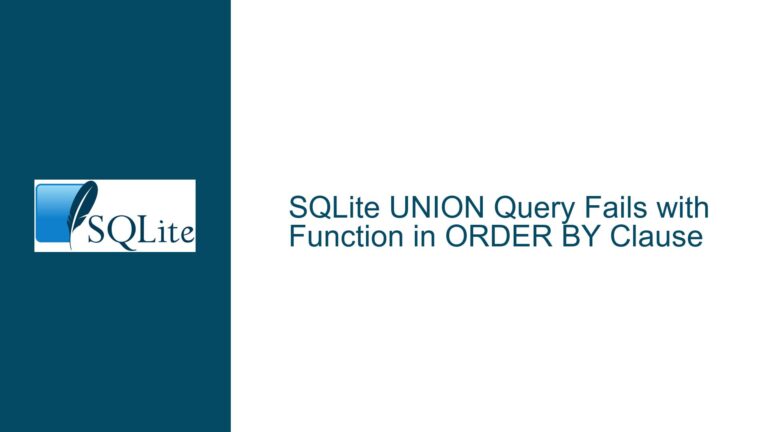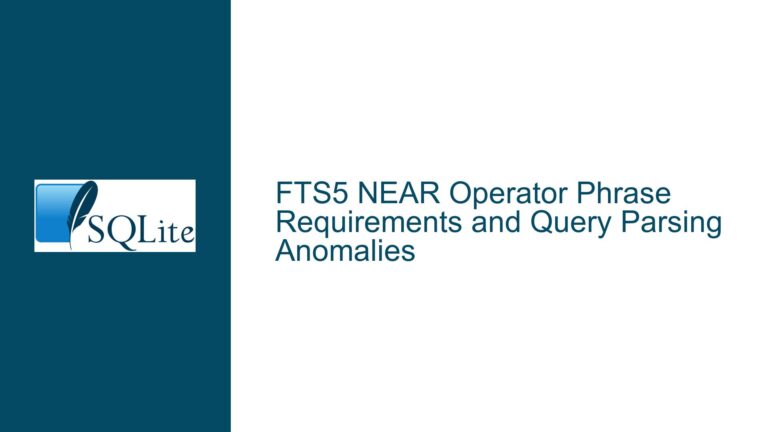NULL vs null in SQLite JSON Functions and Documentation Clarity
Issue Overview: JSON NULL vs SQL NULL in SQLite JSON Functions
The core issue revolves around the distinction between JSON’s null and SQL’s NULL in SQLite’s JSON functions, specifically json_extract(), ->, and ->>. The confusion arises from the documentation’s examples, which initially used NULL (uppercase) in JSON strings, leading to "malformed JSON" errors when executed. This discrepancy highlights a critical misunderstanding of how SQLite interprets JSON data and SQL’s NULL values.
JSON, as a data format, is case-sensitive and only recognizes null (lowercase) as a valid keyword to represent a null value. On the other hand, SQLite’s NULL is a distinct concept, representing the absence of a value in SQL. The documentation initially conflated these two concepts by using NULL in JSON strings, which is invalid JSON syntax. This misalignment between the documentation and SQLite’s actual behavior caused confusion among users, who expected the examples to work as written.
The issue is further compounded by the fact that SQLite’s JSON functions, such as json_extract(), ->, and ->>, are designed to handle both JSON strings and SQL NULL values. When a JSON string contains NULL (uppercase), SQLite correctly identifies it as malformed JSON and throws an error. However, when the JSON string contains null (lowercase), SQLite processes it correctly, returning null as expected. This behavior aligns with the JSON specification but conflicts with the initial documentation examples.
The documentation’s examples in sections 4.4 and 4.5 of the JSON1.html document were the primary source of confusion. These examples used NULL in JSON strings, which is invalid JSON syntax, and did not match SQLite’s actual behavior. Users running these examples encountered errors, leading to questions about whether the issue was a bug in SQLite or a documentation error. The discussion ultimately revealed that the documentation needed clarification to align with SQLite’s implementation and the JSON specification.
Possible Causes: Misalignment Between JSON Specification and SQLite Documentation
The root cause of the issue lies in the misalignment between the JSON specification and the SQLite documentation. JSON is a well-defined data format with strict syntax rules, including the requirement that the null keyword must be lowercase. SQLite’s JSON functions adhere to this specification, rejecting any JSON string that contains NULL (uppercase) as malformed. However, the documentation initially failed to reflect this distinction, leading to confusion among users.
One possible cause of this misalignment is the dual nature of SQLite’s JSON functions, which must handle both JSON strings and SQL NULL values. The documentation attempted to illustrate this duality but inadvertently conflated the two concepts by using NULL in JSON strings. This conflation created ambiguity, as users could not determine whether the examples were intended to demonstrate JSON handling or SQL NULL handling.
Another contributing factor is the case sensitivity of JSON keywords. JSON’s null, true, and false must be lowercase, while SQL’s NULL can be written in any case. The documentation’s use of NULL in JSON strings violated this rule, leading to errors when users attempted to execute the examples. This inconsistency between the documentation and SQLite’s behavior further exacerbated the confusion.
The issue also highlights the importance of clear and accurate documentation, especially when dealing with complex concepts like JSON and SQL NULL. The initial documentation failed to clearly distinguish between JSON’s null and SQL’s NULL, leading to misunderstandings and errors. This underscores the need for precise language and examples in technical documentation to avoid ambiguity and ensure that users can correctly interpret and apply the information.
Troubleshooting Steps, Solutions & Fixes: Aligning Documentation with SQLite’s JSON Handling
To resolve the issue, the SQLite documentation needed to be updated to accurately reflect the behavior of JSON functions and the distinction between JSON’s null and SQL’s NULL. The following steps outline the process of identifying and addressing the documentation errors:
Identify Documentation Errors: The first step was to identify the specific examples in the documentation that used
NULLin JSON strings. These examples were found in sections 4.4 and 4.5 of the JSON1.html document. Running these examples in SQLite resulted in "malformed JSON" errors, confirming that the documentation did not match SQLite’s behavior.Correct JSON Syntax: The next step was to replace
NULLwithnullin the JSON strings used in the examples. This change ensured that the examples adhered to the JSON specification and matched SQLite’s behavior. For instance, the examplejson_extract('{"a":NULL}', '$.a')was corrected tojson_extract('{"a":null}', '$.a').Add Examples for SQL NULL Handling: To further clarify the distinction between JSON’s
nulland SQL’sNULL, additional examples were added to the documentation. These examples demonstrated how SQLite’s JSON functions handle SQLNULLvalues. For instance, the examplejson_extract(NULL, '$.a')was added to show that SQLNULLinputs result in SQLNULLoutputs.Update Documentation: The final step was to update the documentation with the corrected examples and additional clarifications. This involved modifying the relevant sections of the JSON1.html document to ensure that the examples accurately reflected SQLite’s behavior and the JSON specification. The updated documentation now clearly distinguishes between JSON’s
nulland SQL’sNULL, eliminating the confusion caused by the initial errors.Verify Changes: After updating the documentation, the changes were verified by running the corrected examples in SQLite and confirming that the output matched the documented behavior. This step ensured that the documentation was now accurate and aligned with SQLite’s implementation.
By following these steps, the SQLite documentation was brought into alignment with SQLite’s JSON handling, resolving the confusion caused by the initial errors. The updated documentation now provides clear and accurate examples, helping users understand the distinction between JSON’s null and SQL’s NULL and how SQLite’s JSON functions handle each case.
Detailed Explanation of JSON and SQL NULL Handling in SQLite
To fully understand the issue and its resolution, it is essential to delve into the details of how SQLite handles JSON and SQL NULL values. JSON, or JavaScript Object Notation, is a lightweight data interchange format that uses a text-based syntax to represent data structures. JSON supports several data types, including objects, arrays, strings, numbers, and the special values null, true, and false. These special values must be written in lowercase to be valid JSON.
SQLite, on the other hand, is a relational database management system that supports SQL, a language for managing and querying relational data. SQL uses NULL to represent the absence of a value in a database table. Unlike JSON, SQL’s NULL is case-insensitive, meaning it can be written as NULL, null, or any other case variation.
SQLite’s JSON functions, such as json_extract(), ->, and ->>, are designed to work with both JSON strings and SQL NULL values. When a JSON string is passed to these functions, SQLite parses the string according to the JSON specification. If the string contains NULL (uppercase), SQLite rejects it as malformed JSON because NULL is not a valid JSON keyword. However, if the string contains null (lowercase), SQLite processes it correctly, returning null as expected.
When an SQL NULL value is passed to these functions, SQLite treats it as the absence of a value and returns NULL as the result. This behavior is consistent with SQL’s handling of NULL values and ensures that SQLite’s JSON functions can seamlessly integrate with SQL queries.
The distinction between JSON’s null and SQL’s NULL is crucial for understanding how SQLite’s JSON functions work. JSON’s null is a valid JSON value that represents the absence of a value within a JSON structure. SQL’s NULL, on the other hand, represents the absence of a value in a database table or query result. While both concepts represent the absence of a value, they are distinct and must be handled differently in SQLite.
The initial documentation errors arose from the conflation of these two concepts. By using NULL in JSON strings, the documentation created the impression that SQLite’s JSON functions could handle SQL NULL values within JSON strings. However, this is not the case, as JSON strings must adhere to the JSON specification, which only recognizes null (lowercase) as a valid keyword.
The updated documentation now clearly distinguishes between JSON’s null and SQL’s NULL, providing accurate examples that reflect SQLite’s behavior. This clarity helps users understand how to correctly use SQLite’s JSON functions and avoid common pitfalls related to JSON and SQL NULL handling.
Best Practices for Using JSON Functions in SQLite
To avoid confusion and ensure correct usage of SQLite’s JSON functions, it is essential to follow best practices when working with JSON and SQL NULL values. The following guidelines can help users navigate the complexities of JSON and SQL NULL handling in SQLite:
Use Lowercase
nullin JSON Strings: When working with JSON strings in SQLite, always usenull(lowercase) to represent null values. This ensures that the JSON strings adhere to the JSON specification and are correctly processed by SQLite’s JSON functions.Distinguish Between JSON
nulland SQLNULL: Be mindful of the distinction between JSON’snulland SQL’sNULL. JSON’snullis a valid JSON value, while SQL’sNULLrepresents the absence of a value in a database table or query result. Use each appropriately in your SQL queries and JSON strings.Handle SQL
NULLValues Separately: When passing SQLNULLvalues to SQLite’s JSON functions, understand that these values are treated as the absence of a value and will result in SQLNULLoutputs. Do not attempt to include SQLNULLvalues within JSON strings, as this will result in malformed JSON.Verify JSON Syntax: Before passing JSON strings to SQLite’s JSON functions, verify that the strings adhere to the JSON specification. This includes ensuring that all special values (
null,true,false) are written in lowercase and that the overall structure of the JSON string is valid.Consult the Documentation: Always refer to the official SQLite documentation for accurate and up-to-date information on JSON functions and their behavior. The documentation provides detailed examples and explanations that can help clarify any uncertainties.
By following these best practices, users can avoid common pitfalls and ensure that their use of SQLite’s JSON functions is accurate and effective. Understanding the distinction between JSON’s null and SQL’s NULL is key to leveraging the full power of SQLite’s JSON capabilities.
Conclusion
The issue of NULL vs null in SQLite’s JSON functions highlights the importance of clear and accurate documentation, as well as a deep understanding of the underlying concepts. By distinguishing between JSON’s null and SQL’s NULL, and ensuring that documentation accurately reflects SQLite’s behavior, users can avoid confusion and errors when working with JSON data in SQLite.
The updated documentation now provides clear examples and explanations, helping users navigate the complexities of JSON and SQL NULL handling. By following best practices and consulting the documentation, users can effectively leverage SQLite’s JSON functions to manage and query JSON data with confidence.






